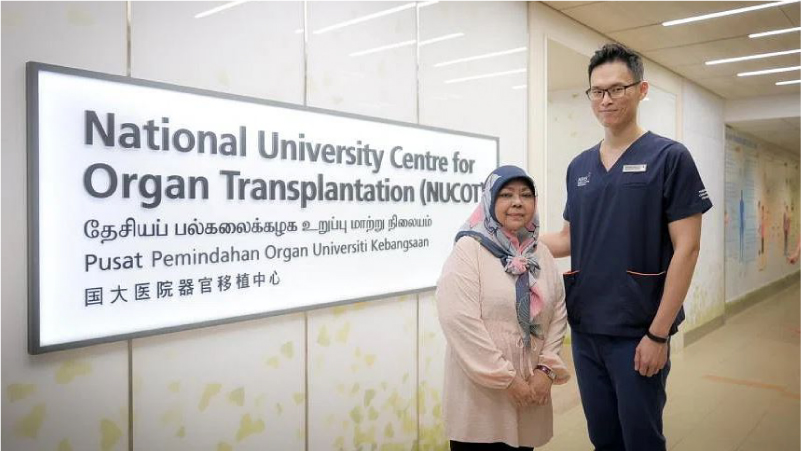New organ
preservation method to cut
transplant waiting times
Thanks to a new preservation method, NUH can improve the
quality of available kidneys to make them suitable for
transplants, shortening critical waiting times and saving lives.
Issue 1 | June 2023
 Source: The Straits Times © SPH Media Limited. Permission required for reproduction.
Source: The Straits Times © SPH Media Limited. Permission required for reproduction.
 Subscribe and ensure you don't miss the next issue!
Subscribe and ensure you don't miss the next issue!
Last year, 612 people were on the waiting list for life-saving organ transplants in Singapore—and over 400 of them were in need of a suitable kidney. The city-state ranks third globally for kidney failure incidence, with six new patients diagnosed daily on top of the 300,000 and counting chronic kidney disease cases.
However, the national kidney transplant rate was only at 16 per million population in 2019, despite the passage of the Human Organ Transplant Act already increasing transplant numbers significantly. Suitable kidneys have remained in short supply, leaving patients waiting for nearly a decade on average.
To meet these pressing needs, a team from National University Hospital’s (NUH)
National University Centre for Organ Transplantation (NUCOT) is piloting a new approach to organ preservation that could make less-than-ideal kidneys for transplantation to have better outcomes. Called hypothermic machine perfusion (HMP), the technique can help reduce the risk of complications during and after the operation, granting patients a new lease of life in a much shorter time.
Wanted: suitable organs
Kidney transplants are the best intervention for
end-stage renal disease as they can provide better survival rates, lower costs and resumption of a relatively normal life for patients post-implantation. But because suitable transplant donors are scarce, patients spend much of their time hooked up to a machine that performs the filtration in the kidneys’ stead—an intervention called dialysis.
Between dialysis sessions and a multi-year waiting list, dealing with kidney disorders can be particularly agonising and shackling, with no hopeful end in sight. This was how Madam Sapiah Isnin felt, as she watched her renal function degrade over time after cysts were found in her kidneys in 2008. By 2013, she had to begin dialysis, coming in three times per week for nine years.
“After my dialysis sessions, I would feel very weak and my shoulders would feel heavy. I would also be in a bad mood,” shares Mdm Isnin.
Despite the desperate need for kidney donors, these organs must meet certain criteria before they can be considered for transplantation, shares
Assistant Professor Benjamin Goh, a consultant with NUCOT’s adult kidney transplantation programme.
“Given the long waiting times and shortage of suitable organs, we increasingly have to accept higher-risk donors with comorbidities or donations after cardiac death. However, these less-than-ideal quality kidneys can affect the recipient’s outcomes after transplantation,” he says.
In Singapore, 30 per cent of kidney transplants from deceased donors may lead to delayed graft function, a complication where the kidney does not work immediately after the operation. During transplantation, the blood circulation into and out of the organ is cut temporarily, and later reestablished as the kidney is introduced into the recipient’s system. However, the halting then restarting of blood flow can lead to tissue damage—also called an ischaemia-reperfusion injury—that further heightens the risk for graft malfunction.
For patients that encounter these transplant issues, hospitalisation stays are usually prolonged, as is the road to recovery, ultimately meaning soaring medical bills.
“HMP can provide a platform for simultaneously evaluating the functionality and optimising the quality of higher-risk organs prior to transplantation,” says Asst Prof Goh.
On borrowed time
While organs are typically preserved on ice without any blood flow, HMP effectively does not cut off circulation during transplantation. Instead, a specialised machine pumps very cold preservation fluid into the kidney for three to four hours before implantation. By simulating how the body circulates fluid throughout the system, this technique can enhance the washout of toxins and microclots in the blood, while also minimising the risk of ischaemia-perfusion injuries.
“Even the tiniest blood vessels are kept open when the fluid is pumped through the donor kidney,” Asst Prof Goh explains. “By the time we implant the organ, it would be ready to accept the blood flow from the patient’s body since it has already been simulated and prepared for immediate functioning.”
Moreover, the technology can help doctors select the kidneys that are viable and functional enough for transplants and distinguish these from the suboptimal and irreparable ones that could end up failing upon implantation, according to
Associate Professor Tiong Ho Yee, surgical director of NUCOT’s adult kidney transplantation programme.
Trials from overseas hospitals have shown that HMP can reduce the risk of delayed graft function by as much as 43 per cent. At NUH, the technology has similarly seen success, with three transplants from deceased donors already completed and three patients now living with renewed vigour.
Mdm Isnin is the first kidney transplant recipient in Singapore to try out the new preservation method. After almost a decade of dialysis sessions, the transplant wholly changed the 66-year-old’s life again in late 2022, giving her more time and less emotional burden to do daily activities without needing the constant hospital visits.
Importantly, the transplant did not give rise to any health-threatening complications such as graft malfunction, allowing her to make a full recovery after her operation.
With the early success of HMP, the NUCOT team is now exploring a collaboration with the Singapore Ministry of Health to accelerate the implementation of the technique on a national scale.
“We envision that HMP can be used for all patients—or at least the deceased donor and higher-risk cases—to cut down significantly on kidney waiting times and give more patients a second chance at life,” says A/Prof Tiong.
Watch to learn more:
Like this article? Simply subscribe to make sure you don't miss the next issue of EnvisioningHealth!